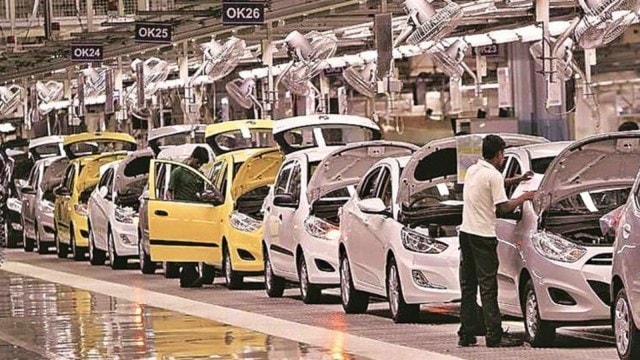How US, EU FTAs can help integrate auto component sector into global value chains: Niti Aayog report explains
By pursuing a combination of fiscal and non-fiscal incentives outlined in the report, NITI Aayog expects India’s auto component exports to triple to $60 billion by 2030, with the country’s share in global value chains rising from 3 to 8 per cent.
 It also recommended a fresh Production Support Scheme to partly cover operational and capital expenditure for auto components left out of the ongoing Production Linked Incentive (PLI) scheme – primarily engines, its components, transmission gears and axles, as well as equipment such as tools and dyes.
It also recommended a fresh Production Support Scheme to partly cover operational and capital expenditure for auto components left out of the ongoing Production Linked Incentive (PLI) scheme – primarily engines, its components, transmission gears and axles, as well as equipment such as tools and dyes.
Free trade agreements (FTAs) with the US and the EU, along with the creation of a conducive environment for foreign joint ventures (JVs), will help integrate India’s burgeoning auto component industry into global value chains, a new NITI Aayog report said on Friday.
It also recommended a fresh Production Support Scheme to partly cover operational and capital expenditure for auto components left out of the ongoing Production Linked Incentive (PLI) scheme – primarily engines, its components, transmission gears and axles, as well as equipment such as tools and dyes.
By pursuing a combination of fiscal and non-fiscal incentives outlined in the report, NITI Aayog expects India’s auto component exports to triple to $60 billion by 2030, with the country’s share in global value chains rising from 3 to 8 per cent.
Strategically negotiated FTAs key
Stressing the importance of FTAs in boosting export competitiveness, NITI Aayog Member Arvind Virmani said such agreements could also increase investment flows into India and facilitate the creation of foreign JVs.
“Most of the M&As (mergers and acquisitions), whether it’s automobiles or other things, are located in the US, EU and a few other countries. That is why FTAs are so important with the US and EU. This is particularly true of network or complex products, for which things move back and forth all over the place,” Virmani said.
India is currently negotiating a bilateral trade deal with Washington and an FTA with Brussels. The report noted that “strategically negotiated” FTAs can encourage foreign investment, technology transfer, and innovation.
JVs with US, German firms for tech transfer
To help foreign JVs thrive in India, it called for a business-friendly environment supported by tax breaks, subsidies, and investment promotion schemes.
“By partnering with foreign companies from countries like Germany, Japan, and the United States, Indian manufacturers can gain access to cutting-edge technology, expertise, and resources, bridging the gap in specialized manufacturing capabilities,” it said.
Highlighting India’s potential to attract foreign JVs, NITI Aayog CEO BVR Subrahmanyam said, “Everybody outside of China is looking at India right now.”
“If you see the way the tariff policies have been evolving in the largest country in the world, we would be a preferred destination. There are small winners, lighthouse countries like Poland, Mexico, and Indonesia. They have captured on that. We are actually missing out on that,” Subrahamnayam said.
“We need to get the large countries, like the Germans and others, who are getting outcompeted to come and do JVs here. The report identifies clusters located within India. There’s no point spreading it thin. Go where you are already strong and expand it further. Two, go to the countries which have the technologies and get it,” he added.
Schemes proposed for brownfield clusters, opex-capex
The report proposed a new scheme to develop brownfield auto clusters into global manufacturing hubs. “There is also a need to undertake a thorough audit of existing auto clusters to evaluate utilization, implementation problems, and the state of facilities provided,” it said.
The eight auto clusters identified in the report are: Delhi-NCR, Pune, Sri City, Chennai, Ludhiana, Pithampur, Rajkot, and Sambhaji Nagar.
The report found that India’s auto component sector faces a 10 per cent cost disadvantage over China, plus an additional 20 per cent differential on manufacturing equipment.
“China benefits from a well-integrated supply chain, spanning from raw minerals to high-value-added products, whereas India lacks such depth in its supply ecosystem,” it said.
As a solution, it proposes opex incentives for producing engine cylinders and cylinder heads, pistons and engine valves, crankshafts and camshafts, and transmission gears and axles, along with capex incentives for tools and dyes.
Despite being the world’s fourth-largest automobile producer after China, US, and Japan, India accounts for just 3 per cent (around $20 billion) of global auto component trade.
Must Read


Buzzing Now
Apr 22: Latest News
- 01
- 02
- 03
- 04
- 05



 The quasi-spherical shaped Aryabhata. (Photo: Isro)[/caption]
Though Isro was established near Thiruvananthapuram considering its proximity to the equator – for conducting experiments during the formative years – the very presence of the sea nearby and the recurrent salt water splashes prevented the setting up of the quintessential instrumentation or clean room facilities for space activities in Kerala’s capital.
Speaking to The Indian Express, Kale said, “That is when it was decided to shift the activities to Bangalore, which offered close proximity to institutions like the Hindustan Aeronautics Limited (HAL), along with a conducive environment supported by the presence of industries.
The Isro Satellite Systems Project was established at Peenya village, once known as Asia’s largest chain of small and medium-scale industries producing engineering and electronics goods.
Designing and building Aryabhata
U R Rao, credited with developing India’s satellite technology, led a 200-member team of engineers and scientists who went on to build Aryabhata at Peenya. Designed with 26 sides and weighing 358 kg, the spacecraft’s quasi-spherical shape was unique. Aryabhata included three scientific experiments: for X-ray astronomy, for observing solar neutrons and gamma rays, and one for studying the upper atmosphere.
The quasi-spherical structure caught the attention of locals in Peenya. S Radhakrishnan, 72, who worked at a factory in Peenya in the 1970s, said, “Every working day, my colleagues and I would walk past the shed ‘A’ (where Isro teams worked) to reach our industry located in shed ‘C’. On some occasions, the Isro engineers would be seen flying some objects and on others, performing some tests or experiments, but we had no clue what they were up to.”
He also mentioned another memory with regard to Aryabhata: catching a glimpse of the then prime minister Indira Gandhi, who had made multiple trips to Bangalore, inspecting Aryabhata at crucial stages ahead of its launch. “Upon learning that the prime minister was visiting, I took some time off duty to catch a glimpse of Indira Gandhi,” Radhakrishnan recalled.
Underneath the shed in Peenya, several first-of-its kind infrastructural facilities – the electronics laboratories, clean room for the final assembly of the satellite, thermal laboratories, control and stabilisation laboratories, antenna testing facilities, a workshop and draughting sections – were set up.
For nearly 30 months, the Isro teams worked for the development of the satellite’s prototypes and testing of the multiple models, ensuring that the highest reliability was achieved. Some of these tests included qualification in a thermo-vacuum chamber, vibration and shock tests. The satellite model was even taken up in a helicopter over Sriharikota during January 1975, kept almost stationary at various distances and altitudes from the ground station and the two-way communication link between the satellite and the ground telemetry station at Sriharikota was checked under simulated power levels of the transmitters.
[caption id="attachment_9953121" align="alignnone" width="600"]
The quasi-spherical shaped Aryabhata. (Photo: Isro)[/caption]
Though Isro was established near Thiruvananthapuram considering its proximity to the equator – for conducting experiments during the formative years – the very presence of the sea nearby and the recurrent salt water splashes prevented the setting up of the quintessential instrumentation or clean room facilities for space activities in Kerala’s capital.
Speaking to The Indian Express, Kale said, “That is when it was decided to shift the activities to Bangalore, which offered close proximity to institutions like the Hindustan Aeronautics Limited (HAL), along with a conducive environment supported by the presence of industries.
The Isro Satellite Systems Project was established at Peenya village, once known as Asia’s largest chain of small and medium-scale industries producing engineering and electronics goods.
Designing and building Aryabhata
U R Rao, credited with developing India’s satellite technology, led a 200-member team of engineers and scientists who went on to build Aryabhata at Peenya. Designed with 26 sides and weighing 358 kg, the spacecraft’s quasi-spherical shape was unique. Aryabhata included three scientific experiments: for X-ray astronomy, for observing solar neutrons and gamma rays, and one for studying the upper atmosphere.
The quasi-spherical structure caught the attention of locals in Peenya. S Radhakrishnan, 72, who worked at a factory in Peenya in the 1970s, said, “Every working day, my colleagues and I would walk past the shed ‘A’ (where Isro teams worked) to reach our industry located in shed ‘C’. On some occasions, the Isro engineers would be seen flying some objects and on others, performing some tests or experiments, but we had no clue what they were up to.”
He also mentioned another memory with regard to Aryabhata: catching a glimpse of the then prime minister Indira Gandhi, who had made multiple trips to Bangalore, inspecting Aryabhata at crucial stages ahead of its launch. “Upon learning that the prime minister was visiting, I took some time off duty to catch a glimpse of Indira Gandhi,” Radhakrishnan recalled.
Underneath the shed in Peenya, several first-of-its kind infrastructural facilities – the electronics laboratories, clean room for the final assembly of the satellite, thermal laboratories, control and stabilisation laboratories, antenna testing facilities, a workshop and draughting sections – were set up.
For nearly 30 months, the Isro teams worked for the development of the satellite’s prototypes and testing of the multiple models, ensuring that the highest reliability was achieved. Some of these tests included qualification in a thermo-vacuum chamber, vibration and shock tests. The satellite model was even taken up in a helicopter over Sriharikota during January 1975, kept almost stationary at various distances and altitudes from the ground station and the two-way communication link between the satellite and the ground telemetry station at Sriharikota was checked under simulated power levels of the transmitters.
[caption id="attachment_9953121" align="alignnone" width="600"] Assembly work in progress for Aryabhata in Bengaluru. (Photo: Isro)[/caption]
Tests were done on a balloon at 25 km in May 1973. The instruments for the scientific experiments, too, were tested and, lastly, the communication link was tested at 400 km, noted Rao in a 1978 research paper published by the Indian Academy of Sciences.
During the first quarter of 1975, the final fabrication phase of two flight models was completed along with the complete integration and testing of the actual flight model performed during the same period.
Simultaneously, in Bangalore, other ground-based support and tracking like the telemetry, telecommand and the communication units were being readied. The functioning of the entire ground station was tested using a helicopter-borne satellite model and simulating the transmitter power levels for the maximum range that the satellite will have during its orbit, to ensure that the ground station can receive the telemetered data from the satellite and send commands to the satellite.
A Mission Operations and Control Centre was set up at Peenya that would coordinate the commanding as well as data-gathering programme from various ground stations.
Even though all the three scientific experiments onboard Aryabhata had to be called off owing to power failure, other technological experiments were performed based on the use of the onboard telecommand, putting to use the transmitter-receiver for data transmission from one station to another using the satellite as a node.
Lasting impact
Today, half a century later, satellite-based communication is well-established and is being widely used, but its roots in India can easily be traced back to Aryabhata and Isro. The first voice transmission of a recorded speech was transmitted from Sriharikota to Bangalore via Aryabhata. Due to its high quality, another experiment involving electrocardiogram (ECG) signals was similarly transmitted – a demonstration of the opportunities and unlimited possibilities that satellite communication could offer in future. The India Meteorological Department in Pune assisted Isro in setting up a weather data gathering (wind speed, temperature, wind direction) platform from standard data collection points.
With over 12,000 electronic components, 20,000 solar cells and more than 25,000 interconnections within the satellite, Aryabhata was a demonstration of India's indigenous abilities to undertake the structural designing of a space-worthy satellite, fabricate and test it, develop thermal and power control systems as well as an entire ground station along with data processing systems.
Assembly work in progress for Aryabhata in Bengaluru. (Photo: Isro)[/caption]
Tests were done on a balloon at 25 km in May 1973. The instruments for the scientific experiments, too, were tested and, lastly, the communication link was tested at 400 km, noted Rao in a 1978 research paper published by the Indian Academy of Sciences.
During the first quarter of 1975, the final fabrication phase of two flight models was completed along with the complete integration and testing of the actual flight model performed during the same period.
Simultaneously, in Bangalore, other ground-based support and tracking like the telemetry, telecommand and the communication units were being readied. The functioning of the entire ground station was tested using a helicopter-borne satellite model and simulating the transmitter power levels for the maximum range that the satellite will have during its orbit, to ensure that the ground station can receive the telemetered data from the satellite and send commands to the satellite.
A Mission Operations and Control Centre was set up at Peenya that would coordinate the commanding as well as data-gathering programme from various ground stations.
Even though all the three scientific experiments onboard Aryabhata had to be called off owing to power failure, other technological experiments were performed based on the use of the onboard telecommand, putting to use the transmitter-receiver for data transmission from one station to another using the satellite as a node.
Lasting impact
Today, half a century later, satellite-based communication is well-established and is being widely used, but its roots in India can easily be traced back to Aryabhata and Isro. The first voice transmission of a recorded speech was transmitted from Sriharikota to Bangalore via Aryabhata. Due to its high quality, another experiment involving electrocardiogram (ECG) signals was similarly transmitted – a demonstration of the opportunities and unlimited possibilities that satellite communication could offer in future. The India Meteorological Department in Pune assisted Isro in setting up a weather data gathering (wind speed, temperature, wind direction) platform from standard data collection points.
With over 12,000 electronic components, 20,000 solar cells and more than 25,000 interconnections within the satellite, Aryabhata was a demonstration of India's indigenous abilities to undertake the structural designing of a space-worthy satellite, fabricate and test it, develop thermal and power control systems as well as an entire ground station along with data processing systems.




















